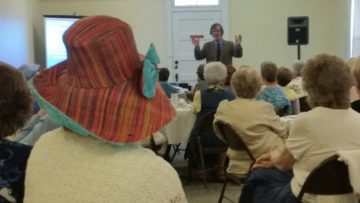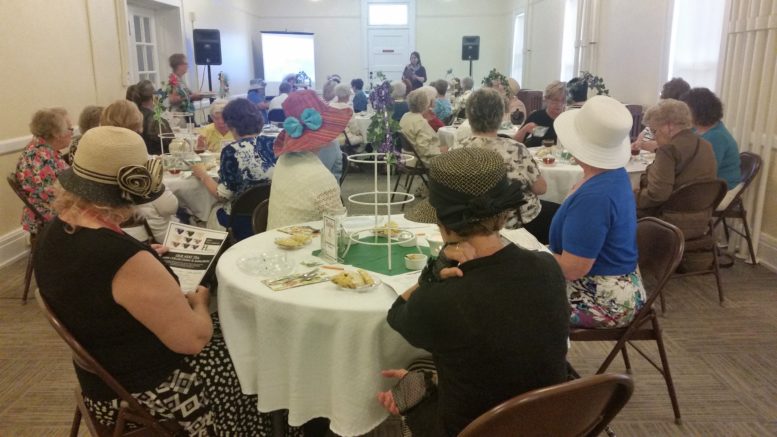By JAN LARSON McLAUGHLIN
BG Independent News
The line between collecting and hoarding is not as fine as some might think. That news seemed to comfort some of the ladies dressed in wide-brimmed hats and lace gloves who had just finished sipping tea and eating scones Thursday at the Wood County Historical Center’s tea titled “When Collections Go Wild.”
“I don’t want to be a party pooper, collecting is great. But sometimes it goes bad,” said speaker Dr. William O’Brien, a psychology professor at Bowling Green State University.
As he addressed hoarding, O’Brien suspected that his audience members were thinking, “I wonder if this is going to be about me?”
But there are distinct differences between collecting and hoarding, he said. Collecting is common and enjoyable. Those who collect feel proud of their collections and share them with others.

Dr. William O’Brien talks about hoarding.
“People don’t hoard out of joy,” O’Brien said.
Collecting rarely interferes with social functioning, and those who do it are able to acquire items carefully and discard items they no longer want.
In contrast, hoarders are often ashamed of the items they have compulsively accumulated. “They don’t want people to come over to their house.” Hoarders have great difficulty discarding things even if they have no value. They become anxious just thinking about getting rid of things, O’Brien said.
Collecting to compulsion can be a slippery slope, he said. “The line is when the home environment is interrupted.” At that point, hoarding can lead to marital and family strife. “The non-saver tries to sneak things out of the home” to make it livable, which may only add to the stress.
Approximately 1 to 2 percent of the U.S. population are “clinically hoarders,” O’Brien said. The problem is experienced worldwide, not just in the U.S. where material goods are more accessible. The compulsion is seen more with women, and with dementia. Some connect the behavior with “nesting.”
Hoarding can lead to social isolation, debt due to purchasing and storage costs, family conflicts and landlord problems. It can also create problems when valuable items, such as insurance papers, cannot be found among mountains of other items.
Most hoarders only seek help when their compulsion results in an eviction or family turmoil. “Most people with a hoarding disorder don’t seek treatment,” until a crisis occurs, he said. “They aren’t generally there willingly.”
Hoarding behavior often falls into three categories. The first is someone who views meaningless things as precious with great sentimental value – consequently they can’t be discarded. “People attach meaning to objects,” O’Brien said.
The second is utilitarian, which may be more common among people who lived through tough times such as the Depression. O’Brien held up his Styrofoam cup as an item that a hoarder might decide to save so it could be used as a planter in the spring. “We all do this, but it becomes a problem when we have 500 cups laying around.”
The third type of hoarder assigns aesthetic value to useless things. That person might look at a broken tea cup handle and save it because it could be part of a beautiful collage some day.
O’Brien told of a woman surrounded by stacks of old newspapers and magazines, who was unable to discard them because somewhere in the stacks there might be an article that could change her life.
“All of us assign value to things,” he said. But that must be balanced. “When I die, my kids are just going to throw it out anyway.”

Hoarders are awfully good at delaying decisions. They avoid discarding items by putting them in bins, in a corner, or in storage.
Treatment for hoarding involves learning to deal with the stress of throwing out items. Families coming in and shoveling out the house would be very distressing. In order to lessen hoarding behavior, the person must agree to suffer for a purpose. In other words, the pain of discarding items may be deemed worthwhile if it leads to the person’s children coming to visit.
O’Brien compared the process to exposure therapy for people who are afraid of spiders, who step by step become more comfortable with the creatures. With hoarding, the exposure therapy is a graded process in which the person can build up tolerance to their distress felt by discarding items.
Expectations should be tempered, he added. A hoarder will not go from having a cluttered home to becoming a neat freak, but they can become functional, he said.
O’Brien said the psychology world is focusing on “mindfulness,” which looks at how to live life the best way possible in the presence of suffering. Instead of spending so much energy on fixing ourselves, this new focus is on embracing imperfections.
“The goal is learning how to live with them and maybe even learning to love them,” he said.

